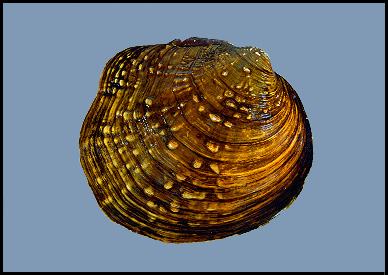
Cyclonaias tuberculata, INHS 4078. Source of photo: http://www.inhs.uiuc.edu:80/chf/pub/mussel_man/cover.html
- list with lots of mollusk links >>http://habanero.cb.uga.edu/GSC/images.html
Below are images
of the aquatic plants seen in lab, or those we are likely to see
during field trips.
During the term, learn to associate the type of plant with the
habitat. Species
in bold must know the common and scientific names and family.
Species denoted
with * you also must be able to site-identify during lab.
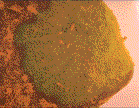
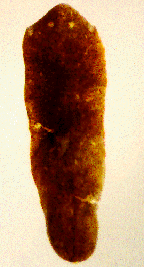
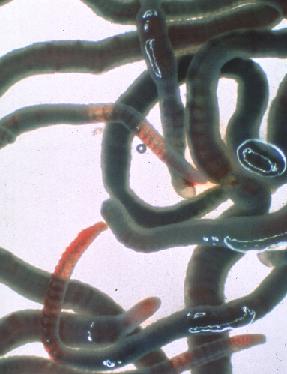
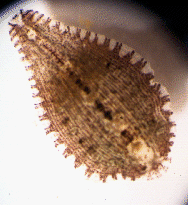
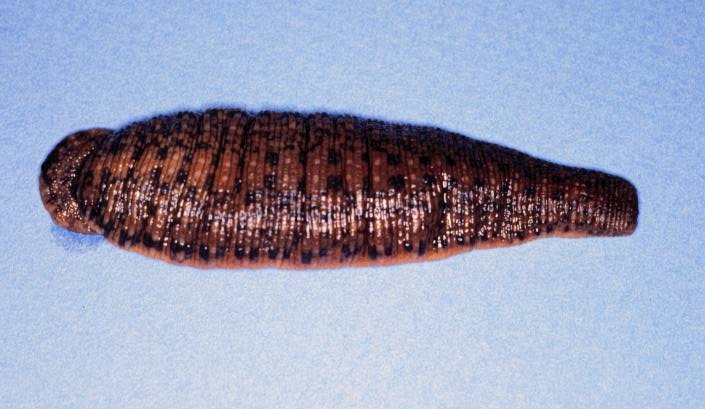
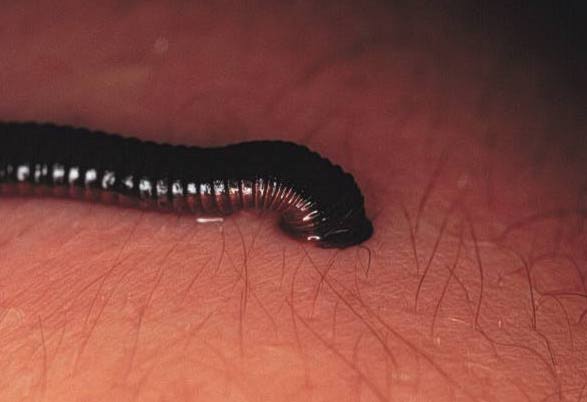
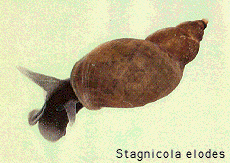
*Class
Pelecypoda (clams and mussels)

Cyclonaias tuberculata, INHS 4078.
Source of photo: http://www.inhs.uiuc.edu:80/chf/pub/mussel_man/cover.html
- list with lots of mollusk links
>>http://habanero.cb.uga.edu/GSC/images.html
Superclass Crustacea
- head and thorax "fused"
into a structure called a cephalothorax
- two pairs of antennae
- breath with gills
Order
Ostacoda - seed or clam shrimp
- minute crustaceans
with large head, its trunk reduced in size
- bivalve calcareous
carapace
- almost all are free-living,
both marine and freshwater forms
*Order
Amphipoda - scuds, side-swimmers
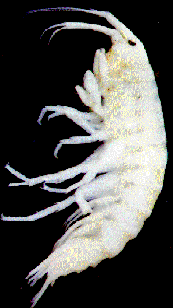
- bilaterally compressed
(narrow), look like tiny shrimp
- head and first segment
of thorax fused into a cephalothorax
- seven free thoracic
segments, with 2 pair of pleopods which beat to move water over the gills
- small tail plate
(telson)
- active at night
- benthic, primarily
scavengers of fine detritus, or shredders
- can be common, some
species adapted adapted to subterranean environments
- two common families
in Michigan - Gammaridae, Hyalellidae
*Order
Isopoda - aquatic sowbugs, isopods
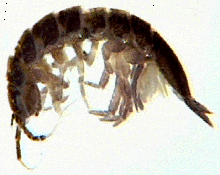
- dorsoventrally
compressed (flat)
- head fused with first
and second segment of thorax into a cephalothorax
- seven other thoracic
segments each with a pair of legs (pereopods)
- four abdominal segments
fused to tail plate (telson)
- six pairs of abdominal
legs (pleopods, and 6th uropods)
- live just about everywhere
and often where other things cannot
- scavengers, hide
in accumulated vegetative matter in rivers and lakes
- one common family
in Michigan - Asellidae
Order Mysideacea - opossum
shrimp
- shrimp-like, with
large carapace, and stalked eyes
- live in deep lakes,
often have dramatic cycles of diurnal vertical migration
*Order
Eucopepoda - copepods
- mostly marine, but
significant numbers of species that are freshwater
- immature copepods
called "nauplius"
- cylindrical shape,
narrow abdomen, often conspicuous as females often are seen carrying egg
sacs
- laterally compressed,
with a single folded carapace
- very small (usually
<0.5-2.0mm), noticeably segmented bogy with numerous appendages on head
and thorax,
and setose caudal rami on posterior end of abdomen
- filter feeders, feed
on organic detritus and other smaller animals; some species parasitic on
fish
- of the free-swimming
species, three important suborders:
- Calanoida, planktonic species with long antennae, filter feeders - dominant
freshwater group
- Cyclopoida, littoral species with short antennae
- Harpacticoida, littoral species with very short antennae (largely a marine
group)
*Order
Cladocera - water fleas
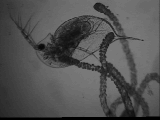
- laterally compressed
(narrow), with a single folded carapace open at the bottom, doesn't cover
head
- 5-6 pairs of legs
- antennae (biramous
Y-shaped) chief locomotive organ
- primary consumers,
visual predators, majority feed on algae and cyanobacteria, use their legs
to filter feed
- often an important
link in aquatic food chains, widely preyed upon by insects and fish
- soon responds to
increases in productivity with turnover events
- reproduction parthenogenetic,
males produced in spring in response to crowding
- populations with
diel vertical migration, staying at depths during the day, rising to near
the surface at night
to feed
- found in most still
water, planktonic in lakes, in weedy lake margins, a few in bogs, along
lake bottoms
or in the
mud
*Order
Anostracea - fairy shrimp
- elongated trunk
- many paired appendages,
swims on back
- stalked, compound
eyes
- carapace absent
*Order
Decapoda - crayfish and freshwater shrimp
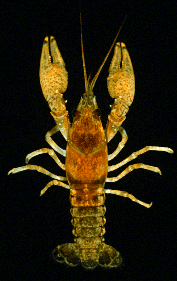
- diverse marine and
freshwater order, some individuals attain the largest size of any of our
crustaceans
- most freshwater decapods
inhabit shallow lentic and lotic waters, also some inhabit terrestrial
burrows
that lead
to groundwater, and some are subterranean (caves)
- head and thorax combined
into a very prominent cephalothorax, which often has an anterior, elongated
projection
(rostrum)
- feathery gills in
a gill chamber underneath the legs
- females carry eggs
on pleopods
- several types of
crayfish borrow into the ground, making chimneys (response to drought)
- largely nocturnal,
omnivorous feeding
Family - Cambaridae - crayfish
- body cylindrical
- appendages modified
- 2 pairs of antennae
- 5 pair of legs used for walking and food handling (1st 3 are chelate,
1st a large forcept)
- 5 pair of pleopods on abdomen
Family - Palaemonidae - freshwater shrimp
- body laterally compressed (narrow)
- first 2 paris of legs are chelate, the rest are adapted for swimming
- generally found in macrophyte-rich littoral zones of lakes or similarly
macrophyte-chocked sections
of rivers and streams
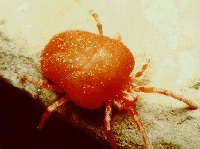
*Class and Order
Collembola - springtails, snow fleas
*Class Insecta -
true insects
*Division and Order Ephemeroptera - mayflies
*Division
and Order Odonata - dragon- and damselflies
Division Neoptera - insects that fold wings behind back
*Order Plecoptera - stoneflies
*Superorder Hemiptera (true bugs) - Order Heteroptera
Endopterygota
Order Neuroptera - spongillaflies
*Order Megaloptera - dobson- and alderflies
*Order Coleoptera - beetles
*Order Trichoptera - caddisflies
Order Lepidoptera - moths and butterflies
*Order Diptera - true flies
Class "Agnatha" - jawless
fish (lampreys, hagfishes)
*Family Petromyzontidae - lampreys
Class Osteichthyes
- bony fishes
Order Lepisosteiformes (gars)
Family Lepisosteidae - gars
Order Amiiformes (bowfins)
Family Amiidae - bowfins
Order Clupeiformes (herring-like fishes)
*Family Salmonidae - trouts and salmon
Family Umbridae - mudminnows
*Family Esocidae - pikes
Order Cypriniformes - minnows, suckers, catfishes
*Family Cyprinidae - minnows and carps
*Family Catostomatidae - suckers
*Family Ictaluridae - catfishes, madtoms
Order Perciformes - perches, sunfishes, sculpins
*Family Percidae - perches and darters
*Family Centrarchidae - sunfishes and bass
*Family Cottidae - sculpin
Family Gasterosteidae - sticklebacks
Class Amphibia - frogs and toads, salamanders and newts, caecilians